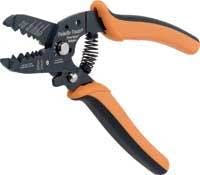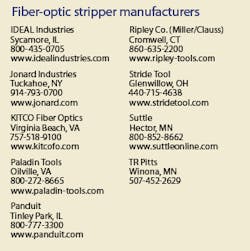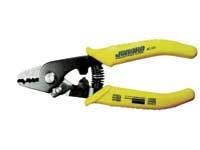Essential fiber strippers shift into multi-functional gear
Though often more expensive than popular single-use tools, newer multi-use strippers are designed to offer more functionality and more reliable stripping.
Before the connector or splicer gets involved, and even before the cleaver takes action, the fiber-termination process begins with the fiber stripper. While they are not the most glorious or most expensive tools in fiber-optic cabling, strippers play an important role. While choosing a fiber stripper is primarily based on what you’re used to using, several innovative tools are available that may make you want to re-evaluate your choice.
Strip with care
Glass fiber used in the telecommunications industry has a nominal diameter of 125 microns (µm), and it is coated with a 250-µm acrylate buffer, which is applied as part of the manufacturing process. The acrylate protects the fiber against damage and helps minimize optical loss. Before termination and splicing, the acrylate coating is usually scraped off of the glass fiber with a stripper, and the bare fiber is then cleaned with a swipe of alcohol to remove remaining residue. This process must be carefully executed to avoid scoring or breaking the fiber.
"Not only do technicians need to know the type of fiber they're stripping and have the right tool for the job, but the fiber itself is so fine and delicate that there is no room for error," says Michael Frank, marketing manager for Jonard (OK) Industries (www.jonard.com). "Ultimately, they need to ensure clean, consistent stripping without nicking or damaging the glass fiber."
Some connector manufacturers require a certain amount of acrylate to remain on the fiber, and specific applications do not allow the use of a stripper to remove the acrylate.
"The technician may not always want to strip off the acrylate with a hand tool," explains Les Shutts, engineering manager for Paladin Tools (www. paladin-tools.com). "For example, some military applications require the 250-µm acrylate to be removed with specialized chemicals to avoid any residual substance that can affect optical loss."
The 250-µm coated fiber is used in the two common types of fiber cable construction-loose-tube buffer and tight buffer.
Loose-tube construction, deployed in outdoor applications, places the 250-µm-coated fibers in a gel-like substance that protects the fibers from temperature, moisture, and physical stress.
In tight-buffer designs, deployed in most indoor premise applications, the individual 250-µm fibers are coated with an additional plastic 900-µm buffer that must be stripped off prior to termination and splicing. Within the cable, the 900-µm buffered fibers are grouped together and surrounded with aramid (Kevlar) strength members and covered with a PVC outer jacket, which must also be stripped off. Simplex and duplex tight-buffered fiber cables, commonly deployed in the premise environment, have a 2 to 3-mm outside diameter.
In addition, multi-fiber ribbon cable is a flat cable, which is constructed by grouping twelve 250-µm-coated fibers side by side and then coating them with plastic. "Ribbon cable's flat construction requires a special stripper for stripping off the outer jacket," says Jim McCandless, applications engineer for Ripley (www.ripley-tools.com), manufacturer of Miller and Clauss brand tools. "Once the jacket is stripped, the plastic coating that encompasses the twelve 250-µm acrylate coated fibers must be removed using thermal or chemical stripping methods."
Single-use strippers
In addition to familiarity and comfort, an obvious selection consideration for many installers is price. Strippers range anywhere from $20 to over $100, depending on brand, features, overall grade. "Many technicians lose their strippers and tend to go through them pretty quickly," says Dan Payerle, datacomm marketing manager, Ideal Industries (www.idealindustries.com). "Cost is, therefore, one of the concerns, especially for technicians just starting out."
Single-use strippers designed to only remove the 250-µm buffer remain popular because they are less expensive, and they're what most experienced technicians were trained on and are accustomed to using. "Many technicians use a single-use 250-µm stripper to remove both the 900-µm buffer and 250-µm acrylate in one stripping motion," explains Ripley's McCandless. "However, this requires a lot of technique and experience to avoid breaking the fiber."
Ripley's Miller FO 103-S and Clauss No-Nik and CFS-2 strippers are single-use strippers for stripping the 250-µm acrylate buffer down to the 125-µm fiber. Jonard Industries offers the JIC-125 single-use stripper for the same purpose. These tools are preset at the factory and designed to prevent nicks or scratches on the glass fiber.
"The key is to have a precise 125-µm opening across every tool designed to remove the 250-µm buffer and reveal the glass fiber," says McCandless.
Multi-use strippers include more than one hole for stripping a variety of buffer and jacket sizes. Multi-use strippers tend to cost more than single-use versions, and some technicians have complained that they increase the potential to use the wrong sized hole. But multi-use strippers are also designed to offer more functionality, more reliable stripping, and fewer tools to carry around.
The multi-use tool
Ripley offers two dual-hole fiber-optic strippers. The FO 103-D-J includes one hole for removing the 250-µm buffer down to the 125-µm fiber and a second hole for stripping the 2 to 3-mm fiber jacket. Ripley's FO 103-D-250 dual-hole stripper includes a second hole for stripping the 900-µm tight buffer down to the 250-µm acrylate.
"We're trying to make the strip more reliable with holes specifically designed for each buffer," says Sean Powell, sales manager for Ripley. "The FO 103-D-250 is more reliable for stripping the 900-µm buffer down to the 125-µm glass fiber in two steps versus the technique-sensitive single-use tools." Powell also points out that some connector manufacturers specify leaving a certain amount of the 250-µm acrylate coating on the fiber, which requires a hole designed to only remove the 900-µm buffer.
Ripley's most recent multi-use stripper, the FO 103-T-250-J Tri-Hole stripper (pictured above), combines all three functions in one compact tool. It includes one hole for removing the 2 to 3-mm jacket, a second hole for removing the 900-µm buffer to the 250-µm acrylate, and a third hole for stripping the 250-µm acrylate down to the 125-µm glass fiber.
Late last year, Jonard Industries unveiled a similar 3-hole stripper, the JIC-375 (page 69), for stripping the 2 to 3-mm jacket, 900-µm buffer, and 250-µm acrylate. "We looked at the complaints for multi-use strippers, and we've done our best to ensure that the technician uses the proper hole, even in dim light," says Frank. "We've etched pictures of the different parts of the fiber directly onto the tool next to its specific hole, as well as printing the information on the tool's handle."
Ideal Industries offers two multi-use fiber strippers. The Lite-Strip is a higher-end tool with pre-adjusted blades for stripping off the outer jacket, 900-µm buffer, and 250-µm acrylate in three separate steps, which the company says is ideal for novice technicians. The MiniLite-Strip includes one hole for stripping 900-µm directly down to the 125-µm glass fiber and a second hole for stripping the outer jacket.
"The MiniLite-Strip is becoming popular mainly because of its price of about $35, which is almost half the cost of others," says Payerle. "It's a very ergonomic, compact tool, and our customers like the way it fits in their hand and offers better stability and control."
Also last year, Paladin Tools introduced the FiverOptic Stripper (page 65), the first fiber stripper with five specific holes for stripping 2.8 to 3-mm jackets, 2 to 2.4-mm jackets, 2 to 3-mm loose-tube jackets, 900-µm buffer, and 250-µm acrylate.
"The FiverOptic Stripper is the only multi-use tool with a specific hole for cutting into the jacket of loose-tube fiber,” claims Shutts. “It's designed to just score it enough so you can snap the jacket off and avoid touching the fibers inside. The FiverOptic is a high precision tool being offered at a lower cost, which is one the main reasons for its success." According to Shutts, getting the FiverOptic stripper into several OEM fiber prep and termination kits has been another method for success.
"The FiverOptic utilizes diamond-shaped holes, which offer better contact on all four sides and allow you to hold the tool perpendicular to the fiber when stripping," says Shutts. Manufacturing perfectly round holes at these sizes is virtually impossible, he adds, which is why other tools use elliptical-shaped stripping holes. "The elliptical shape can require holding the tool on an angle or rocking it back and forth, which can cause scoring of the fiber," Shutts says.
Time for a change?
Sticking with a traditional single-use stripper may be the easiest course of action, but the benefits provided by newer multi-use tools may be cause for reconsideration.
"Up until now, the single-use tools have been the predominant stripper,” acknowledges Sean Powell, sales manager for Ripley. “Change takes time, and we're starting to see a shift. While the multi-use tools offer more functionality, it still comes down to what the technician was trained on. As more technicians entering the industry are trained on multi-use tools, or acquire them as part of a termination kit, we anticipate multi-use tools to grow in popularity."
Whether you continue to use a single-use tool or choose to shift to a multi-use version, tool manufacturers all agree that the key to stripping fiber is choosing precision tools from a reputable manufacturer.
"Cheaper imported tools have not gained ground here in the U.S., because although they can pull off stripping for a certain amount of time, they can't consistently perform or maintain proper tolerances over the life of the tool," says Ripley's McCandless.BETSY ZIOBRON is a freelance writer covering the cabling industry, and a frequent contributor to Cabling Installation & Maintenance. She can be reached at: [email protected]




